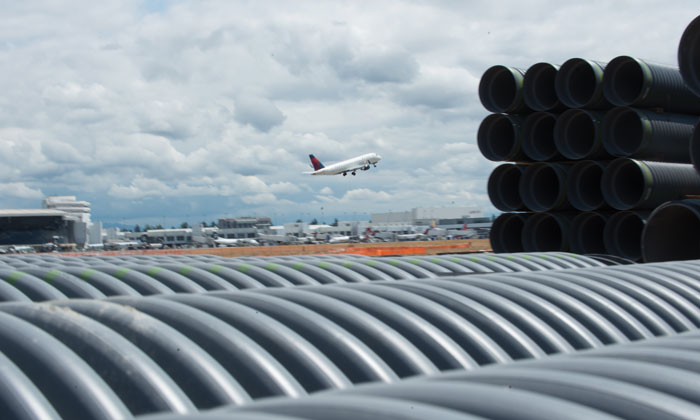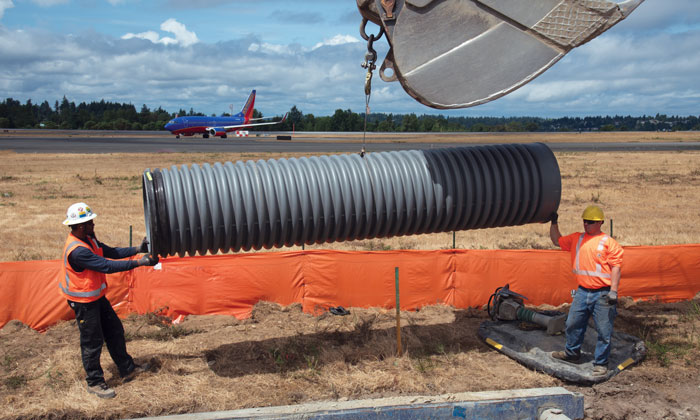The importance of storm water drainage for airports
- Like
- Digg
- Del
- Tumblr
- VKontakte
- Buffer
- Love This
- Odnoklassniki
- Meneame
- Blogger
- Amazon
- Yahoo Mail
- Gmail
- AOL
- Newsvine
- HackerNews
- Evernote
- MySpace
- Mail.ru
- Viadeo
- Line
- Comments
- Yummly
- SMS
- Viber
- Telegram
- Subscribe
- Skype
- Facebook Messenger
- Kakao
- LiveJournal
- Yammer
- Edgar
- Fintel
- Mix
- Instapaper
- Copy Link
Posted: 3 July 2017 | International Airport Review | 1 comment
Steve Cooper discusses the important of storm water drainage for airports citing case studies including Seattle-Tacoma’s as a current example…


During the past several years there has been a lot of construction at U.S. airports. As usual, everyone is thrilled when they see above-ground improvements, but what they don’t appreciate is how important the underground infrastructure is to the airport. This article covers the way in which some U.S. airports are handling their storm water drainage.
In the case of any work at any airport, safety is the underlying goal, closely followed by that of speed. Any project involved in the field itself must meet those two requirements. However, handling pipes for a storm water system as large as 1,524mm (60 inches) in diameter can be a problem for both speed and safety. Traditional 1,220mm (48 inches) diameter reinforced concrete pipe (RCP) is generally 2.44m (8ft) long and can weigh up to four metric tonnes (9,000 pounds).
Many airports have found the solution to be a lighter weighing alternative that still provides the strength and integrity required by the airport, engineers and the U.S. Federal Aviation Administration (FAA).
West Coast winner
At Sea-Tac – Seattle-Tacoma International Airport (Washington State) – rebuilding the 46-year old centre runway wasn’t limited to just the pavement. To comply with strict FAA criteria regarding drainage within Runway Safety Areas, as well as provide environmental enhancements for runoff, the Port of Seattle, operator of the airport, also elected to upgrade the storm water drainage system.
According to Chris Coulter, P.E. of engineering firm HNTB, “There were a variety of overlapping requirements that needed to be met. This included assurances that there would be zero ponding within the Runway Safety Area, zero pipe failures, rapid pipe installation, meet FAA grant eligibility requirements, and that the pipe would be structurally robust for use within the Runway Safety Area.”
Chris continued: “Furthermore, the Port has very strict monitoring requirements for storm water release, so we needed a product that had proven joint reliability. Our aviation group in the Seattle office was contacted to assist with the storm water conveyance design for the Runway 16C-34C reconstruction project. The system drains the centre of the airfield, which encompasses about 59 hectares (145 acres) of both airfield pavement and runway safety area.”
Built in 1969, Runway 16C/34C is the oldest of the three runways at the northwest’s largest airport and is 2,873m (9,426ft) long. The surface is made up of more than 4,000 concrete panels of which more than 600 have been replaced during the past 20 years to keep the runway operational. The $95 million total reconstruction project was completed in October 2015.
Sea-Tac is the 13th busiest U.S. airport, serving more than 42 million passengers and handling more than 332,000 metric tonnes of air cargo in 2015. Twenty-four airlines serve 81 non-stop domestic and 24 international destinations.
“The runway we were reconstructing had outlived its useful life by about 20 years,” explained Chris, who was the QA/QC Construction Manager for the project. “So it was long overdue for reconstruction and while doing that much work in a short amount of time, the Port wanted to make sure all bases were covered. This meant that the project would include a whole new storm water conveyance infrastructure to improve drainage from the paved areas and bring the infield area to a better state for deviation of any aircraft from the paved surfaces. The runway safety area needs to be able to support aircraft, whether it’s on pavement or not. Plus, there’s always a concern about bird strikes, which means there’s no standing water allowed. Period. We designed the system to have the capacity for a 24-hour, 100-year storm and used about three miles of pipe that would provide the required hydraulic characteristics.”
The storm water management system used some 4,877m (16,000 linear feet) of 300-914mm (12-36 inch) diameter pipe, most of which was thermoplastic pipe – SaniTite HP pipe – from Advanced Drainage Systems, Inc. (ADS). The company designs and manufactures water management components that include its well-known N-12 corrugated high-density polyethylene (HDPE) pipe.
ADS’ SaniTite HP pipe’s stiffness and beam strength minimises deflection and enhances long-term performance. It meets ASTM F2736, ASTM F2764 and exceeds ASTM D3212 for water tightness with dual-gaskets and a banded reinforced bell. Made from an advanced, engineering grade of polypropylene, its designed service life exceeds 100 years. Burial depth at the airport ranged from 1.2m-3.65m (4ft-12ft).


In 2014 the FAA approved the use of polypropylene pipe for subsurface water collection and disposal at civilian airports. The decision to recognise polypropylene pipe as an equal alternative to other materials enables design engineers and contractors to leverage the benefits of the lightweight, cost-effective and durable solution for water collection and removal under airfield pavements. This action followed the FAA approval of HDPE pipe for under pavement use in all airport areas including de-icing pads, runways and taxiways.
Chris has more than 18 years of experience, and most of that time he says has been spent overseeing lengths of pipe being put into the ground at Sea-Tac. “We’ve gone away from RCP out here a long time ago,” Chris stated. “It just doesn’t do anything for us with time savings. The ADS pipe comes in longer 6m (20ft) lengths and that also means far fewer joints along the entire system.”
Chris continued: “We found the stiffness of the SaniTite HP pipe very helpful during construction.” “One of the things that was very hard with this project was the limited duration of tine we had to finish. We were doing a lot of work in 180 days.”
Chris explained further: “Obviously, the pipe was a small monetary part but a large time saving component. We could not shut down the whole runway at once because aircraft still had to get through the area safely. There wasn’t a whole lot of time to put pipe in the ground as we were concentrating on paving and grading – that’s the job. The pipe work had to go quickly. We use the term ‘set it and forget it’.”
Southern success
In November 2015 the new storm water drainage system was completed for the Jackson-Medgar Wiley Evers International Airport (JAN) in Jackson, Mississippi. Key to the requisite installed efficiency of the project was the use of 3,962m (13,000ft) of thermoplastic pipe in diameters up to 1,524mm (5ft). The pipe was used to replace reinforced concrete pipe (RCP) that was failing, and also for new runs. The project was designed and overseen by WEI/AJA, a joint venture between Waggoner Engineering and AJA Management & Technical Services.
“The project was initiated because the airport was having issues maintaining the airfield,” explained Will Pentecost, P.E., and Project Manager for WEI/AJA. “The original concrete pipe had reached the end of its design life. It had been in the ground for more than 60 years and was starting to experience joint failures, causing sinkholes which were safety risks. What they had was a safety issue for maintenance personnel, and the sinkholes could have caused damage to an aircraft if it left the runway. There were some large sinkholes on the airfield where they were losing material through the concrete pipe joints. Also, if the drainage could not be maintained it would allow water to accumulate and would have been a concern because birds would congregate there and increase the potential for bird strikes.”
Will continued: “We conducted an evaluation of all the storm drainage on the airfield and compiled a report on the condition of each pipe run and inlet. We then designed a project to meet the airport’s current budget and needs at the time and to immediately address the worst areas.”
The airport, with two runways, encompasses some 1,335 hectares (3,300 acres) and services approximately 20 commercial aircraft daily. It is also home of the 172nd Airlift Wing of the Mississippi Air National Guard.
“Originally the project was designed using reinforced concrete pipe in order to meet FAA specifications,” explained Will. “But I liked the idea of fewer joints. Generally, most problematic issues are encountered in the use of concrete pipes, and on that airfield most of the pipe was fairly deep.”
In addition to meeting long-life and other performance criteria, the pipe would need to provide an efficient means of installation. Safety and speed were critical factors. “Speed was the key,” exclaimed Will. “There are only two runways, so shutting down one for an extended period of time to install the pipe was not a favourable option.”
The bid specifications from Waggoner called for ADS HP pipe to be considered as an alternative. “This did help to keep the prices in line with the budget and added competition to the bidding process,” Will stated.
ADS HP pipe is a high-performance polypropylene pipe designed and manufactured by the company for gravity-flow storm drainage applications. It couples advanced polypropylene resin technology with a proven, dual-wall profile design for superior performance and durability. The smooth interior wall offers additional strength as well as superior flow. It meets ASTM F2736, ASTM F2881 and AASHTO M330 for the respective diameters. The pipe is approved for use by the Army Corps of Engineers for storm drainage applications. HP pipe has a patented extended, reinforced bell with a polymer composite band and dual gaskets that add an additional factor of safety within each joint, according to the company. The HP pipe joint performance meets or exceeds the 10.8 psi laboratory performance standards per ASTM D3212 requirements. Pipe sections are 6m (20ft) long and can be easily moved with minimal equipment and crew. In addition to storm water drainage, ADS pipe is also used in other under pavement airport areas including de-icing pads, runways and taxiways.
Will explained: “The ADS HP pipe fitted (the specifications) and at the same time the FAA was in the process of approving that pipe. It all just kind of fell together. It was after we advertised the project that the FAA approved the ADS HP pipe. So we included it as an alternative by addendum prior to the bid. For Hemphill Construction this was the first time they used it and they seemed to like it because the pipe was easy to handle and install.”
The system was designed by Will and his WEI/AJA team for a 25-year storm. They re-evaluated the hydraulics of the entire field and resized some areas that had added or expanded buildings and parking lots. The watertight pipe ranged from 609mm-1,524mm (24 to 60 inches) in diameter and traditional precast structures were also used.
The new ADS HP pipe was installed as the old RCP was being removed, using the same pathway. Burial depth ranged from 1.22 to 4.88m (4ft-16ft) with the average being 2.4 to 3m (8ft-10ft). Will explained: “In the design process we were going to specify a granular material for bedding, but ADS preferred to add a select sandy material, instead of a granular one, to the springline of the pipe and another backfill material above it. They preferred a homogeneous material all the way around the pipe.”
Commenting about the pipe, Will said: “It sped up construction for sure. Every piece of pipe we installed required at least one taxiway closure. During construction, staging and closures were required throughout, so the quicker the crew could complete an area the more convenient it was for everyone at the airport.”



















I hadn’t ever really considered just how important stormwater drainage could be for an airport, but it makes sense. I found it particularly interesting how you mentioned that the drainage needs to be good enough to keep any standing water from existing since birds will be attracted to it and cause a hazard at an airport. It seems too that the size and length of pipe installed in these drainage systems can largely depend on the location of the airport and the type of climate it experiences.